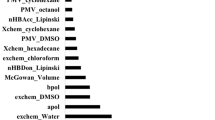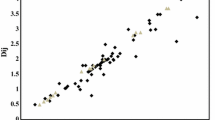Abstract
Membrane-interaction QSAR (MI-QSAR) and Holographic QSAR (HQSAR) analyses have been performed on a diverse set of drugs and drug-like molecules. MI-QSAR combines a set of membrane-solute interaction properties calculated during molecular dynamics simulation with the set of classical solute descriptors to predict the biological behavior of drugs and drug-like molecules. HQSAR is a technique which employs fragment fingerprints or molecular holograms as predictive variables of biological activity. A data set of 60 structurally diverse molecules with permeability coefficients were used to construct significant MI-QSAR and HQSAR models of Caco-2 cell permeation. A statistically meaningful MI-QSAR model was obtained with r 2 = 0.805 and q 2 = 0.696. Subsequently, HQSAR models were developed on the same data set. The best HQSAR model (r 2 = 0.915, q 2 = 0.539) was obtained with fragment distinctions atom, bond, donor and acceptor with atom count 4 to 7. The predictions for training and test set molecules are in good agreement with experimental results and show the potential of models for untested compounds. This displays the importance of MI-QSAR and HQSAR analysis in estimating ADME properties characterized by the transport of solutes through biological membranes.










Similar content being viewed by others
References
Van de Waterbeemd H, Gifford E (2003) ADMET in silico modelling: towards prediction paradise? Nat Rev Drug Discov 2:192–204
Wishart DS (2007) Improving Early Drug Discovery through ADME: An Overview. Drugs R&D 8:349–362
Singer SJ, Nicolson GL (1972) The fluid mosaic model of the structure of cell membranes. Science 175:720–731
Conradi RA, Burton PS, Borchardt RT (1996) Physico-chemical and biological factors that influence a drug’s cellular permeability by passive diffusion. Methods Princ Med Chem 4:233–252
Delie F, Rubas WA (1997) A human colonic cell line sharing similarities with enterocytes as a model to examine oral absorption: advantages and limitations of the Caco-2 model. Crit Rev Ther Drug Carrier Syst 14:221–286
Artursson P, Palm K, Luthman K (2001) Caco-2 monolayers in experimental and theoretical predictions of drug transport. Adv Drug Deliv Rev 46:27–43
Lipsinki CA, Lomabardo F, Dominy BW, Feeney PJ (1997) Experimental and computational approaches to estimate solubility and permeability in drug discovery and development settings. Adv Drug Deliv Rev 23:3–25
Camenisch G, Folkers G, van de Waterbeemd H (1996) Review of theoretical passive drug absorption models: historical background, recent developments and limitations. Pharm Acta Helv 71:309–327
Chan O, Stewart BH (1996) Physicochemical and drug-delivery consideration for oral drug bioavailability. Drug Discov Today 1:461–473
Palm K, Stenberg P, Luthman K, Artursson P (1997) Polar molecular surface properties predict the intestinal absorption of drugs in humans. Pharm Res 14:568–571
Camenisch G, Alsenz J, van de Waterbeemd H, Folkers G (1998) Estimation of permeability by passive diffusion through Caco-2 cell monolayers using drugs’ lipophilicity and molecular weight. Eur J Pharm Sci 6:313–319
Ponce YM, Cabrera Pérez MA, Zaldivar VR, Ofori E, Montero LA (2003) Total and local quadratic indices of the “molecular pseudograph’s atom adjacency matrix”. application to prediction of caco-2 premeability of drugs. Int J Mol Sci 4:512–536
Iyer M, Tseng YJ, Senese CL, Liu J, Hopfinger AJ (2007) Prediction and mechanistic interpretation of human oral drug absorption using MI-QSAR analysis. Mol Pharm 4:218–231
Fujiwara SI, Yamashita F, Hashida M (2002) Prediction of caco-2 cell permeability using a combination of mo-calculation and neural networks. Int J Pharm 237:95–105
Norinder U, Osterber T, Artursson P (1997) Theoretical calculation and prediction of caco-2 cell permeability using molsurf parametrization and pls statistics. Pharm Res 14:1786–1791
Cruciani G, Crivori P, Carrupt PA, Testa B (2000) Molecular fields in quantitative structure-permeation relationships: the volsurf approach. J Mol Struct THEOCHEM 503:17–30
Kulkarni A, Han Y, Hopfinger AJ (2002) Predicting Caco-2 cell permeation coefficients of organic molecules using membrane-interaction QSAR analysis. J Chem Inf Comput Sci 42:331–342
Liang E, Chessic K, Yazdanian M (2000) Evaluation of an accelerated Caco-2 cell permeability model. J Pharm Sci 89:336–345
Ponce YM, Perez MAC, Zaldivar VR, Diaz HG, Torrens F (2004) A new topological descriptors based model for predicting intestinal epithelial transport of drugs in Caco-2 cell culture. J Pharm Sci 7:186–199
Zhu C, Jiang L, Chen TM, Hwang KK (2002) A comparative study of artificial membrane permeability assay for high throughput profiling of drug absorption potential. Eur J Med Chem 37:399–407
Yee S (1997) In vitro permeability across Caco-2 cells (colonic) can predict in vivo (small intestinal) absorption in man–fact or myth. Pharm Res 14:763–766
Pade V, Stavchansky S (1998) Link between drug absorption solubility and permeability measurements in Caco-2 cells. J Pharm Sci 87:1604–1607
Yazdanian M, Glynn SL, Wright JL, Hawi A (1998) Correlating partitioning and caco-2 cell permeability of structurally diverse small molecular weight compounds. Pharm Res 15:1490–1494
SYBYL Molecular Modeling System, version 7.1, Tripos Inc., St. Louis, MO, 63144–2913, USA
HYPERCHEM, version 4.5, Hypercube Inc, Waterloo, Ontario Canada N2L 3X2
Van der Ploeg P, Berendsen HJC (1982) Molecular dynamics simulation of a bilayer membrane. J Chem Phys 76:3271–3276
MI-QSAR, Version 1.0, The Chem21 Group Inc, 1780 Wilson Drive, IL, 60045, USA
Kulkarni AS, Hopfinger AJ (1999) Membrane-interaction QSAR analysis: Application to the estimation of eye irritation by organic compounds. Pharm Res 16:1245–1253
Hauser H, Pascher I, Pearson RH, Sundell S (1981) Preferred conformation and molecular packing of phosphatidylethanolamine and phosphatidylcholine. Biochim Biophys Acta 650:21–51
Kulkarni A, Hopfinger AJ, Osborne R, Bruner LH, Thompson ED (2001) Prediction of eye irritation from organic chemicals using membrane-interaction QSAR analysis. Toxicol Sci 59:335–345
Iyer M, Mishra R, Han Y, Hopfinger AJ (2002) Predicting blood–brain barrier partitioning of organic molecules using membrane–interaction QSAR analysis. Pharm Res 19:1611–1621
Doherty DC, MOLSIM, Version 3.0, The Chem21 Group Inc, 1780 Wilson Drive, IL, 60045, USA
Berendsen HJC, Postma JPM, van Gunsteren WF, DiNola A, Haak JR (1984) Molecular dynamics with coupling to an external bath. J Chem Phys 81:3684–3690
Liu J, Li Y, Pan D, Hopfinger AJ (2005) Predicting permeability coefficient in ADMET evaluation by using different membranes-interaction QSAR. Int J Pharm 304:115–123
Kodithala K, Hopfinger AJ, Thompson ED, Robinson MK (2002) Prediction of skin irritation from organic chemicals using membrane-interaction QSAR analysis. Toxicol Sci 66:336–346
Iyer M, Tseng YJ, Senese CL, Liu J, Hopfinger AJ (2006) Prediction and Mechanistic Interpretation of Human Oral Drug Absorption Using MI-QSAR Analysis. Mol Pharm 4:218–231
Li Y, Liu J, Pan D, Hopfinger AJ (2005) A study of the relationship between cornea permeability and eye irritation using membrane-interaction QSAR analysis. Toxicol Sci 88:434–446
Powell MJD (1977) Restart procedures for the conjugate gradient method. Math Program 12:241–254
Lowis DR (1997) HQSAR a new, highly predictive QSAR technique. Tripos Tech Notes 1:1–7
Rodrigues CR, Flaherty TM, Springer C, McKerrow JH, Cohen FE (2002) CoMFA and HQSAR of acylhydrazide cruzain inhibitors. Bioorg Med Chem Lett 12:1537–1541
Moda TL, Montanari CA, Andricopulo AD (2007) Hologram QSAR model for the prediction of human oral bioavailability. Bioorg Med Chem 15:7738–7745
Honorio KM, Garratt RC, Andricopulo AD (2005) Hologram quantitative structure–activity relationships for a series of farnesoid X receptor activators. Bioorg Med Chem Lett 15:3119–3125
Castilho MS, Guido C, Andricopulo AD (2007) Classical and hologram QSAR studies on a series of tacrine derivatives as butyrylcholinesterase inhibitors. Lett Drug Des Discov 4:106–113
Borgström L, Nyberg L, Jönsson S, Lindberg C, Paulson J (1989) Pharmacokinetic evaluation in man of terbutaline given as separate enantiomers and as the racemate. Br J Clin Pharmacol 27:49–56
Acknowledgments
The authors thank Department of Science and Technology (DST), Delhi, and Council of Scientific and Industrial Research (CSIR), New Delhi for financial assistance.
Author information
Authors and Affiliations
Corresponding author
Rights and permissions
About this article
Cite this article
Shinde, R.N., Srikanth, K. & Sobhia, M.E. Insights into the permeability of drugs and drug-likemolecules from MI-QSAR and HQSAR studies. J Mol Model 18, 947–962 (2012). https://doi.org/10.1007/s00894-011-1121-5
Received:
Accepted:
Published:
Issue Date:
DOI: https://doi.org/10.1007/s00894-011-1121-5




